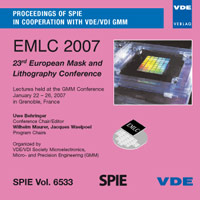Enabling Defect-free Masks for Extreme Ultraviolet Lithography
Conference: EMLC 2007 - 23rd European Mask and Lithography Conference
01/22/2007 - 01/26/2007 at Grenoble, France
Proceedings: EMLC 2007
Pages: 7Language: englishTyp: PDF
Personal VDE Members are entitled to a 10% discount on this title
Authors:
Jeon, Chan-Uk; Kearney, Patrick; Ma, Andy (SEMATECH, 255 Fuller Road, Albany NY, 12203 USA)
Randive, Rajul; Reiss, Ira (Veeco Instruments, Inc., Plainview, NY 11803 USA)
Beier, Bernd (Schott Lithotec)
Uno, Toshiyuki (Asahi Glass Company)
Abstract:
Extreme ultraviolet lithography (EUVL) requires nearly defect-free reflective mask blanks to be economically viable. This has driven the development of tools and processes for depositing and characterizing ultra-low defect density masks, the focus of our study. The Nexus(TM) low defect deposition (LDD) module is an ion beam sputter deposition tool installed at the Mask Blank Development Center (MBDC) at SEMATECH. It has achieved a reflective multilayer coating-added defect density as low as ~0.005 def/cm2 for particles 70 nm and larger on a commercial 6" square quartz substrate. To the best of our knowledge, this is the cleanest coating deposited to date on a commercial substrate. Also, since mask substrate defects can nucleate coating defects, ultra-clean substrates are required. Despite significant advances in mask substrate cleaning techniques, the incoming substrates contribute more defects than the multilayer coating process to the total number of defects on our lowest defect density mask blanks. This is because cleaning processes are ineffective against substrate pits, which dominate the substrate defect distribution. Fortunately, defect mitigation methods have been developed that use a silicon coat-and-etch process to planarize substrate pit and particle defects. A version of the Nexus(TM) LDD module designed primarily for planarizing substrate pits and particles has been installed at the MBDC. This tool has several features, such as the ability to isolate the etch source during deposition steps, that should enable the planarization process to be done more cleanly. We present initial results on the performance of this tool and process.


